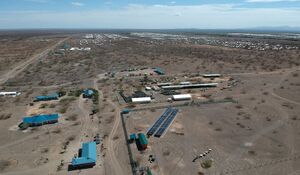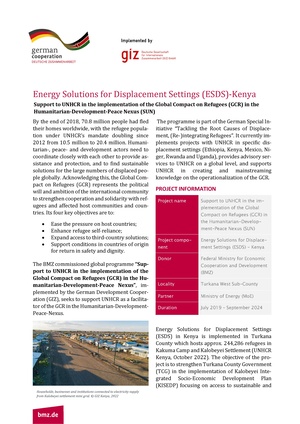Knowledge fuels change
For over a decade, Energypedia has shared free, reliable energy expertise with the world.
We’re now facing a serious funding gap.
Help keep this platform alive — your donation, big or small, truly matters!
Thank you for your support
Difference between revisions of "Humanitarian Energy Situation in Kenya"
***** (***** | *****) m Tag: 2017 source edit |
***** (***** | *****) (Updated ESDS Kenya Factsheet) |
||
| Line 8: | Line 8: | ||
Despite having about 75% of Kenyan households having access to electricity, counties like Turkana still have electricity access rates as low as 10% with almost the half of refugees being connected to solar PV systems while 30% are connected to mini-grid electricity ([[End-User Finance Study & Payment Systems Research in Displacement Settings in Kenya|based on the analysis of interviews in this study]]). Improving access to sustainable energy for households and social institutions via market-based approaches will first require addressing end-user finance barriers, opportunities to enhance market development of energy products and services within the displacement contexts, and the incorporation of development and humanitarian organizations to remedy market failures. | Despite having about 75% of Kenyan households having access to electricity, counties like Turkana still have electricity access rates as low as 10% with almost the half of refugees being connected to solar PV systems while 30% are connected to mini-grid electricity ([[End-User Finance Study & Payment Systems Research in Displacement Settings in Kenya|based on the analysis of interviews in this study]]). Improving access to sustainable energy for households and social institutions via market-based approaches will first require addressing end-user finance barriers, opportunities to enhance market development of energy products and services within the displacement contexts, and the incorporation of development and humanitarian organizations to remedy market failures. | ||
| + | |||
| + | ====== The ESDS Kenya factsheet can be downloaded here ====== | ||
| + | [[File:Updated ESDS Kenya Factsheet 25-Jan-2023.pdf|alt=Updated ESDS Kenya Factsheet|center|thumb|The ESDS Kenya Factsheet]] | ||
= ESDS Region: Refugee Settlements = | = ESDS Region: Refugee Settlements = | ||
Revision as of 08:21, 9 February 2023
Humanitarian Situation Background
There are more than 500,000 refugees and asylum seekers registered in Kenya with approximately 40% located in Kakuma Refugee Camp and Kalobeyei Settlement in Turkana County. Since inception of the refugee camps in Kakuma, the Government of Kenya restricted them from moving outside the camps, seeking education and employment, though this has slightly changed over time. The restriction of movement for refugees reduces their livelihood opportunities and results to overreliance on humanitarian aid. This in turn restricts their ability to add value to the hosting economy leading to an increase in informal businesses and trade. The refugees say this restriction would leave them hopeless, kill their dreams, and limit their thinking. There are notable government restrictions against use of mobile phones and mobile banking by refugees, but the host communities have allowed some of the refugees to register for SIM cards through informal agreements.There is a fairly good network coverage in Kakuma and Kalobeyei refugee camps and host towns with a number of airtime shops and mobile money agents. About 85% of the host town residents have a mobile phone while 69% of refugees have a mobile phone. Over 86% of mobile phone users in host community use it for mobile banking, money transfer and payments as compared to 31% of those in refugee camps. This use of mobile banking, transfer and payments in town is higher than in the refugee camps and can be attributed to the regulatory restrictions on foreigners use of mobile banking. 19% of camp residents access internet via their mobile phone as compared to 33% of town residents.
Despite having about 75% of Kenyan households having access to electricity, counties like Turkana still have electricity access rates as low as 10% with almost the half of refugees being connected to solar PV systems while 30% are connected to mini-grid electricity (based on the analysis of interviews in this study). Improving access to sustainable energy for households and social institutions via market-based approaches will first require addressing end-user finance barriers, opportunities to enhance market development of energy products and services within the displacement contexts, and the incorporation of development and humanitarian organizations to remedy market failures.
The ESDS Kenya factsheet can be downloaded here
ESDS Region: Refugee Settlements
Ressources
Partners
GIZ's Energy Solutions for Displacement Settings (ESDS) project cooperate with UNHCR to enhance the access to sustainable energy in displacement contexts, and the Energypedia page has been created to share learnings across various practitioners to spur the development of clean energy solutions.






















